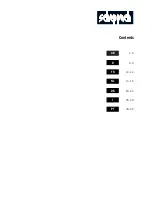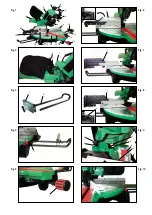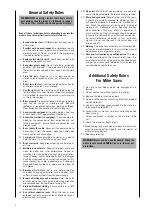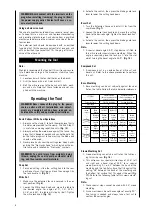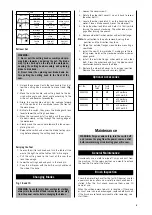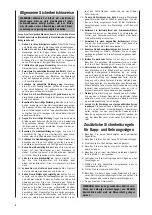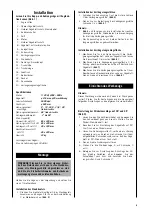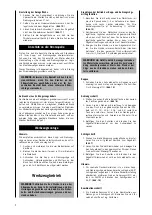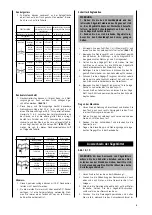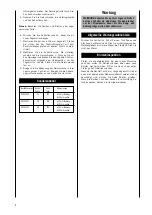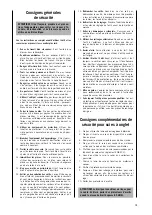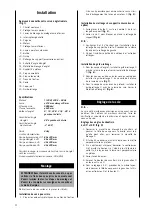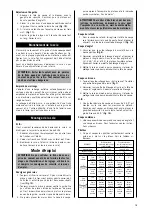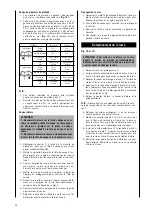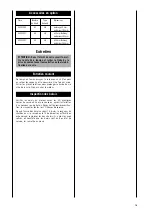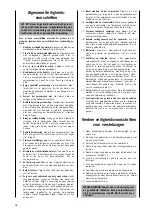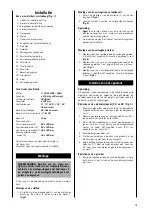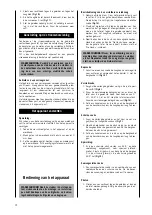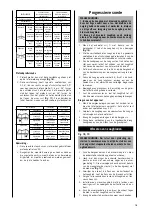
WARNING! Avoid contact with the terminals on the
plug when installing (removing) the plug to (from)
the power supply outlet. Contact will cause a se-
vere electrical shock.
Using an Extension Lead
The use of any extension lead will cause some loss of pow-
er. To keep this to a minimum and to prevent overheating
and possible motor burn-out, ask advice from a qualified
electrician to determine the minimum wire size of the ex-
tension lead.
The extension lead should be equipped with an earthed
type plug that fits the power supply outlet at one end, and
with an earthed type socket that fits the plug of this ma-
chine at the other end.
Mounting the Tool
Note:
We highly recommend that you bolt this mitre saw secure-
ly to a work bench to gain the maximum stability of your
machine.
1. Locate and mark the four bolt holes on the bench.
2. Drill the bench with a ø 10 mm drill bit,
3. Bolt the mitre saw on to the bench with bolts, wash-
ers and nuts. Note that these fasteners are not sup-
plied with the machine.
Operating the Tool
WARNING! Never connect the plug to the power
source outlet until all Installations and adjust-
ments are completed and you have read and un-
derstood the safety and operational instructions.
Basic Pullover Mitre Saw Operations
1. Always use the clamp
①
to hold the work piece firmly.
Six holes are provided for the clamp. The End Stop
➁
is useful when making repetitive cuts.
(Fig. 12)
2. Always position the work piece against the fence. Any
piece that is bowed or warped and cannot be held flat
on the table or against fence may trap the blade and
should not be used.
3. Never place hands near the cutting area. Keep hands
outside the ”No Hands Zone” which includes the en-
tire table and is labelled by ”No Hands” symbols.
WARNING! To avoid injury from materials being
thrown, unplug the saw to avoid accidental start-
ing, and then remove small materials.
Chop Cut
1. For chop cutting, slide the cutting head to the rear
position as far as it will go, and lock the carriage
➀
by
the lock handle
➁
.
(Fig. 14)
Mitre Cut
1. Make sure the extension fence is secured in the cor-
rect position.
(Fig. 6)
2. Loosen the Mitre Lock Knob and move the table to
the desired angle. For angles of 0°, 15°, 22.5°,
31.6°, and 45°, the table will stop by itself. Tighten
the mitre lock knob.
(Fig. 13)
3. Activate the switch, then press the blade guard lock
lever to lower the cutting head down.
Bevel Cut
1. Turn the Extension Fence and install it far from the
saw blade.
(Fig. 7)
2. Loosen the bevel lock handle and move the cutting
head to the desired angle. Tighten the bevel lock han-
dle.
3. Activate the switch, then press the blade guard lock
lever to lower the cutting head down.
Note:
1. A special bevel angle 33.9° stop device is fitted to
this mitre saw for special crown moulding. When this
angle is required, place the lock pin
➀
into the slot
whilst turning the bevel angle to 33.9°.
(Fig. 15)
Compound Cut
1. A compound cut is a combination of mitre cut and
bevel cut. Refer to the above procedures to perform
this cut.
Base Moulding
1. Base moulding can be cut vertically against fence or
flat on the table. Follow the table below for reference.
Crown Moulding Cut
1. Crown moulding can only be cut flat on the table us-
ing this mitre saw.
(Fig. 16)
2. This mitre saw has special mitre stops of 31.6° left
and right and a bevel stop of 33.9° for a special
crown moulding
①
i.e. 52° between the back of the
moulding and the top flat surface that fits against the
ceiling; 38° between the back of the moulding and
the bottom flat surface that fits against the wall
(Fig.
17).
Refer to the following table for this crown mould-
ing cut.
Note:
1. These special stops cannot be used with 45° crown
moulding.
2. Since most rooms do not have angles of exactly 90°,
fine tuning is needed and always take a test cut to
confirm the correct angles.
3
SETTINGS
Extension Fence
Bevel Angle
Moulding Position
Vertical Position
(Back of moulding is flat
against the fence)
Close to the blade
0°
Horizontal Position
(Back of moulding is flat
on the table)
Far from the blade
45°
Inside
corner
Outside
corner
Mitre
Angle
Moulding
position
Finished
side
Mitre
Angle
Moulding
Position
Finished side
Left side
Left at 45°
Bottom
against
table
Keep left
side of cut
Right at 45°
Bottom
against
table
Keep left
side of cut
Right side
Right at 45°
Bottom
against
table
Keep right
side of cut
Left at 45°
Bottom
against
table
Keep right
side of cut
Left side
0°
Top
against
fence
Keep left
side of cut
0°
Bottom
against
fence
Keep right
side of cut
Right side
0°
Bottom
against
fence
Keep left
side of cut
0°
Top
against
fence
Keep right
side of cut
Left
Right
Right
Left


